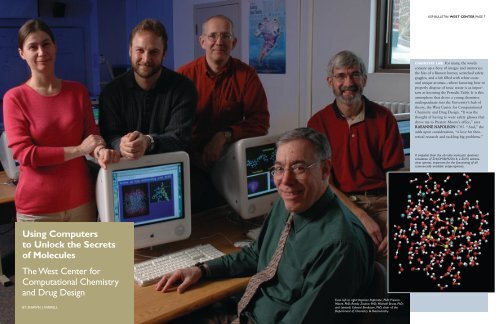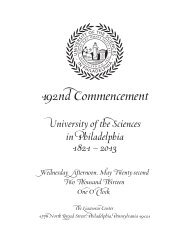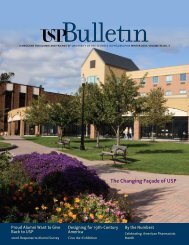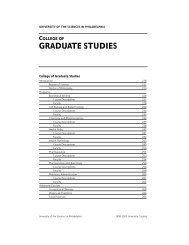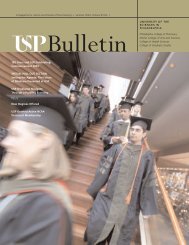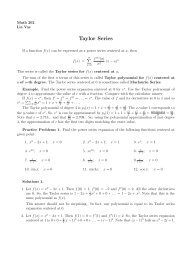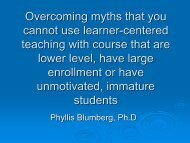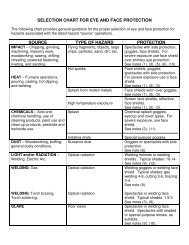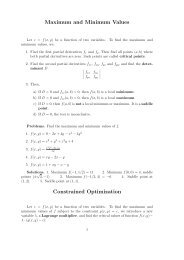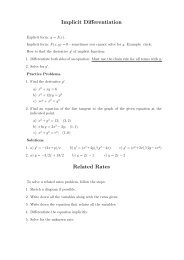Using Computers to Unlock the Secrets of Molecules The West ...
Using Computers to Unlock the Secrets of Molecules The West ...
Using Computers to Unlock the Secrets of Molecules The West ...
You also want an ePaper? Increase the reach of your titles
YUMPU automatically turns print PDFs into web optimized ePapers that Google loves.
USP BULLETIN: WEST CENTER PAGE 7<br />
CHEMISTRY LAB. For many, <strong>the</strong> words<br />
conjure up a bevy <strong>of</strong> images and memories:<br />
<strong>the</strong> hiss <strong>of</strong> a Bunsen burner, scratched safety<br />
goggles, and a lab filled with white coats<br />
and unique aromas—where knowing how <strong>to</strong><br />
properly dispose <strong>of</strong> <strong>to</strong>xic waste is as important<br />
as knowing <strong>the</strong> Periodic Table. It is this<br />
atmosphere that drove a young chemistry<br />
undergraduate in<strong>to</strong> <strong>the</strong> University’s hub <strong>of</strong><br />
<strong>the</strong>ory, <strong>the</strong> <strong>West</strong> Center for Computational<br />
Chemistry and Drug Design. “It was <strong>the</strong><br />
thought <strong>of</strong> having <strong>to</strong> wear safety glasses that<br />
drove me <strong>to</strong> Pres<strong>to</strong>n Moore’s <strong>of</strong>fice,” says<br />
RAEANNE NAPOLEON C’05. “And,” she<br />
adds upon consideration, “a love for <strong>the</strong>oretical<br />
research and tackling big problems.”<br />
A snapshot from <strong>the</strong> ab initio molecular dynamics<br />
simulation <strong>of</strong> Zr4(OH)8(H2O)16, a Zr(IV) tetranuclear<br />
species, important for <strong>the</strong> functioning <strong>of</strong> all<br />
commercially available antiperspirants.<br />
<strong>Using</strong> <strong>Computers</strong><br />
<strong>to</strong> <strong>Unlock</strong> <strong>the</strong> <strong>Secrets</strong><br />
<strong>of</strong> <strong>Molecules</strong><br />
<strong>The</strong> <strong>West</strong> Center for<br />
Computational Chemistry<br />
and Drug Design<br />
BY SHAWN J. FARRELL<br />
From left <strong>to</strong> right: Vojislava Pophristic, PhD; Pres<strong>to</strong>n<br />
Moore, PhD; Randy Zauhar, PhD; Michael Bruist, PhD;<br />
and (seated) Edward Birnbaum, PhD, chair <strong>of</strong> <strong>the</strong><br />
Department <strong>of</strong> Chemistry & Biochemistry.
An illustration representing <strong>the</strong> binding mode between<br />
heparin, a widely used anticoagulant drug (yellow),<br />
and a short aryl amide foldamer, a promising heparinantidote<br />
(red), designed with <strong>the</strong> aid <strong>of</strong> molecular<br />
dynamics simulations. Reprinted with permission<br />
from Angewandte Chemie International Edition,<br />
Volume 44, Issue 41, Oc<strong>to</strong>ber 21, 2005.<br />
It is this fascination with large <strong>the</strong>oretical<br />
problems, problems that require <strong>the</strong> equivalent<br />
<strong>of</strong> 128 computers <strong>to</strong> process, that Napoleon<br />
shares with her research men<strong>to</strong>r and <strong>West</strong><br />
Center Direc<strong>to</strong>r, PRESTON MOORE, PhD.<br />
Dr. Moore is one <strong>of</strong> six full-time researchers<br />
who use <strong>the</strong> <strong>West</strong> Center resources <strong>to</strong> apply<br />
<strong>the</strong>oretical and computational methods <strong>to</strong><br />
chemical and biological problems. <strong>The</strong>se<br />
methods help researchers solve ma<strong>the</strong>matical<br />
models describing <strong>the</strong> nuclei and electrons<br />
that make up small molecules like aspirin<br />
and large protein molecules like hemoglobin.<br />
As <strong>the</strong> ma<strong>the</strong>matical models and computational<br />
power improve, chemists will be able<br />
<strong>to</strong> expand <strong>the</strong>ir ability <strong>to</strong> predict <strong>the</strong> behavior<br />
<strong>of</strong> molecules. This, in turn, will allow<br />
<strong>West</strong> Center researchers <strong>to</strong> solve many practical<br />
problems, including simplifying <strong>the</strong><br />
design <strong>of</strong> new drugs.<br />
VOJISLAVA POPHRISTIC, PhD, for<br />
example, uses “molecular dynamics” computational<br />
methods <strong>to</strong> advance her efforts<br />
<strong>to</strong> develop an antidote <strong>to</strong> heparin, which<br />
is widely used as an anticoagulant drug<br />
for treatment and prevention <strong>of</strong> thrombosis.<br />
RANDY ZAUHAR, PhD, on <strong>the</strong> o<strong>the</strong>r<br />
hand, is developing a “shape signature”<br />
computational method <strong>to</strong> tackle <strong>the</strong> problem<br />
<strong>of</strong> designing drug molecules, or inhibi<strong>to</strong>rs,<br />
against highly mutable targets such as<br />
HIV protease.<br />
Computational chemistry is a rapidly<br />
growing field that is continually developing<br />
more powerful computational <strong>to</strong>ols <strong>to</strong> improve<br />
<strong>the</strong> ability <strong>of</strong> <strong>the</strong>se methods.<br />
According <strong>to</strong> EDWARD BIRNBAUM, PhD,<br />
chair <strong>of</strong> <strong>the</strong> Department <strong>of</strong> Chemistry &<br />
Biochemistry, “As long as Gordon E. Moore’s<br />
law is still applicable and we continue <strong>to</strong><br />
double computational speed every year or<br />
so, we’re going <strong>to</strong> keep finding better ways<br />
<strong>to</strong> do computational work.”<br />
Recognizing <strong>the</strong> field’s potential and seeing<br />
an opportunity <strong>to</strong> lead, <strong>the</strong> University<br />
has made significant investments in staffing<br />
and instrumentation over <strong>the</strong> last five years.<br />
<strong>The</strong> result is a rare combination <strong>of</strong> caliber<br />
and breadth, especially for such a small<br />
department. “A typical department <strong>of</strong> chemistry<br />
with 20 faculty members will have one<br />
computational chemist,” says Dr. Moore.<br />
“We have six.”<br />
<strong>The</strong> <strong>West</strong> Center is also a rare forum for<br />
researchers from disparate fields <strong>to</strong> come<br />
<strong>to</strong>ge<strong>the</strong>r <strong>to</strong> work on common problems but<br />
from different perspectives. “For example,<br />
I’m doing molecular dynamic simulation,<br />
which is one part <strong>of</strong> computational chemistry.<br />
GUILLERMO MOYNA, PhD, is<br />
doing electronic structuring, which is what<br />
“Not only is <strong>the</strong> <strong>West</strong> Center<br />
a vital resource for our own<br />
researchers throughout <strong>the</strong><br />
University, but now with <strong>the</strong><br />
future possibility <strong>of</strong> short<br />
courses, it also has great<br />
potential for affecting our<br />
industry partners nationally.”<br />
SUSAN BARRETT<br />
Assistant Vice President for<br />
Corporate, Foundation, and<br />
Alumni Relations<br />
most people associate with <strong>the</strong>oretical<br />
chemistry. MICHAEL BRUIST, PhD, is<br />
investigating <strong>the</strong> dynamics <strong>of</strong> DNA in<br />
DNA-protein structures and unusual DNA<br />
structures, and ZHIJUN LI, PhD, is doing<br />
bioinformatics homology modeling, which<br />
is a way <strong>of</strong> determining protein structure<br />
so that drugs can be designed virtually on a<br />
computer,” says Dr. Moore. “It’s very diverse,<br />
but all have a need for large computations.”<br />
<strong>The</strong> National Science Foundation (NSF)<br />
<strong>West</strong> Center Direc<strong>to</strong>r, Dr. Pres<strong>to</strong>n Moore and Niny Rao, PhD.<br />
cited USP’s concentration <strong>of</strong> expertise and<br />
common need and its focus on collaborative<br />
research as <strong>the</strong> major fac<strong>to</strong>rs in its decision<br />
<strong>to</strong> award <strong>the</strong> University a nationally competitive<br />
Major Research Instrumentation<br />
grant in 2004. “It was a fea<strong>the</strong>r in our cap,”<br />
says Dr. Moore, “because USP’s proposal<br />
was pitted against larger <strong>to</strong>pflight research<br />
institutions like University <strong>of</strong> Illinois and<br />
Carnegie Mellon University.”<br />
Awarded on merit alone, Dr. Moore’s<br />
NSF grant allowed <strong>the</strong> University <strong>to</strong> purchase<br />
a Beowulf Supercomputer Cluster<br />
with <strong>the</strong> processing capability <strong>of</strong> 128 computers.<br />
<strong>The</strong> NSF grant, although critical<br />
<strong>to</strong> <strong>the</strong> advancement <strong>of</strong> <strong>the</strong> <strong>West</strong> Center,<br />
built on <strong>the</strong> early accomplishments <strong>of</strong> Dr.<br />
Birnbaum, who advocated for <strong>the</strong> establishment<br />
<strong>of</strong> a center for computational chemistry<br />
and secured <strong>the</strong> first successful grant<br />
from <strong>the</strong> H.O. <strong>West</strong> Foundation.<br />
Without <strong>the</strong> visionary generosity <strong>of</strong><br />
<strong>the</strong> H.O. <strong>West</strong> Foundation, Drs. Zauhar<br />
and Moyna—USP’s first computational<br />
chemists—would not have been able <strong>to</strong><br />
fashion <strong>the</strong> University’s first computer cluster<br />
(20 CPUs) that established <strong>the</strong> center<br />
that bears <strong>the</strong> foundation’s name.<br />
On <strong>the</strong> momentum <strong>of</strong> this early and<br />
steady success, <strong>the</strong> <strong>West</strong> Center is driving<br />
forward. “Our immediate goals at <strong>the</strong><br />
<strong>West</strong> Center are threefold,” says Dr.<br />
Birnbaum, “<strong>to</strong> reach out <strong>to</strong> <strong>the</strong> corporate<br />
community with consulting services and<br />
possibly a series <strong>of</strong> short courses in computational<br />
chemistry, <strong>to</strong> expand <strong>the</strong> pr<strong>of</strong>ile<br />
and use <strong>of</strong> <strong>the</strong> center throughout <strong>the</strong> various<br />
departments in <strong>the</strong> University, and <strong>to</strong> <strong>of</strong>fer<br />
more research opportunities <strong>to</strong> students,<br />
particularly undergraduates.”<br />
This latter effort is what allowed<br />
Napoleon <strong>to</strong> contribute <strong>to</strong> research that has<br />
culminated in three published papers and<br />
one pending publication. Now a graduate<br />
student at <strong>the</strong> University <strong>of</strong> Pennsylvania,<br />
Napoleon says she feels lucky about “getting<br />
in on <strong>the</strong> ground floor…when <strong>the</strong> <strong>West</strong><br />
Center was basically me and Dr. Moore.”<br />
Napoleon cites<br />
her research experience<br />
at <strong>the</strong> <strong>West</strong><br />
Center as one reason<br />
she feels she<br />
has a jump on her<br />
graduate school<br />
peers. After three<br />
years working with<br />
Dr. Moore in <strong>the</strong><br />
<strong>West</strong> Center,<br />
Napoleon has a<br />
clearer sense <strong>of</strong> her<br />
research interests.<br />
As her own academic<br />
career and<br />
research interests<br />
flourish,<br />
so, <strong>to</strong>o, does<br />
<strong>the</strong> <strong>West</strong><br />
Center.<br />
According <strong>to</strong><br />
Napoleon,<br />
“Based on <strong>the</strong><br />
growth I’ve seen<br />
over <strong>the</strong> past few<br />
years, I have no<br />
doubt that <strong>the</strong> <strong>West</strong><br />
Center is on <strong>the</strong> verge<br />
<strong>of</strong> national recognition.”<br />
Establishing <strong>the</strong> <strong>West</strong><br />
Center as a nationally recognized<br />
center <strong>of</strong> excellence<br />
is on <strong>the</strong> minds <strong>of</strong> everyone<br />
involved with <strong>the</strong> center. SUSAN<br />
BARRETT, MEd, assistant vice president<br />
for corporate, foundation, and alumni<br />
relations, works closely with <strong>the</strong> <strong>West</strong> Center<br />
and shares its goals. “<strong>The</strong>re are incredible<br />
opportunities for everyone,” says Barrett.<br />
“Not only is <strong>the</strong> <strong>West</strong> Center a vital resource<br />
for our own researchers throughout <strong>the</strong><br />
University,” she notes, “but now with <strong>the</strong><br />
future possibility <strong>of</strong> short courses, it also<br />
has great potential for affecting our industry<br />
partners nationally.”<br />
<strong>The</strong> <strong>West</strong> Center is now exploring how<br />
best <strong>to</strong> <strong>of</strong>fer a series <strong>of</strong> short courses in<br />
computational chemistry and related areas<br />
specifically geared for a corporate or industry<br />
audience. <strong>The</strong>se proposed one- <strong>to</strong> two-day<br />
workshops will be designed <strong>to</strong> introduce<br />
industrial scientists and managers <strong>to</strong> <strong>the</strong><br />
power <strong>of</strong> <strong>the</strong> methodology and <strong>the</strong> <strong>to</strong>ols<br />
used in computational chemistry and<br />
improve <strong>the</strong> skills <strong>of</strong> scientists who are<br />
already well versed in this methodology.<br />
<strong>The</strong>re’s no doubt that <strong>the</strong> <strong>West</strong> Center<br />
is an active labora<strong>to</strong>ry—having generated<br />
over 20 published papers in <strong>the</strong> last two<br />
years alone—but for now, it only has <strong>the</strong><br />
resources <strong>to</strong> process one large ma<strong>the</strong>matical<br />
problem at a time. As interest among<br />
University and industry researchers grows,<br />
time with <strong>the</strong> computer becomes a tighter<br />
commodity. It’s a lot like astronomers<br />
scheduling time at a mountain<strong>to</strong>p telescope.<br />
With such a diverse group<br />
A computer-generated<br />
model <strong>of</strong> how a protein<br />
inserts in<strong>to</strong> a membrane.<br />
<strong>The</strong> lipid-bilayer surface<br />
area initially increases as<br />
<strong>the</strong> protein makes contact,<br />
followed by contraction as<br />
<strong>the</strong> protein inserts in<strong>to</strong> <strong>the</strong><br />
bilayer. Reprinted with permission<br />
from Biophysical<br />
Journal, May 2005,Volume<br />
88, Number 5.<br />
<strong>of</strong> researchers and students<br />
vying for processing time,<br />
it’s up <strong>to</strong> Dr. Moore <strong>to</strong><br />
arrange <strong>the</strong> schedule. When<br />
asked how he manages this<br />
task, Dr. Moore smiled<br />
and replied, “We created an<br />
algorithm.” Naturally.


